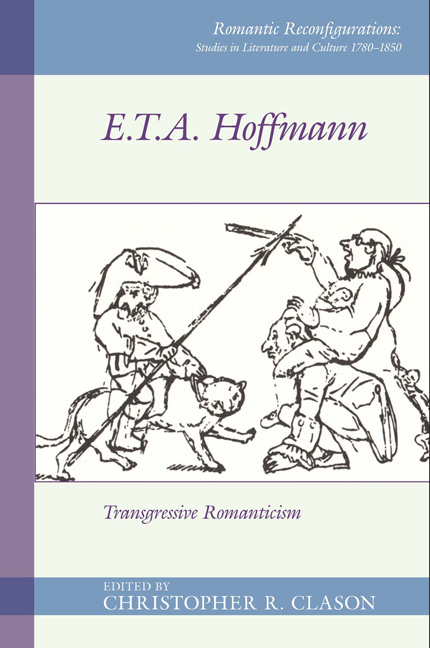Book contents
- Frontmatter
- Contents
- List of Figures
- Acknowledgements
- Notes on Contributors
- Introduction
- I Transgression and Institutions
- II Transgression and the Arts
- III Transgression in the Märchen
- IV Transgression of Reception in Kater Murr
- 10 Hoffmann's “Two Worlds” and the Problem of Life-Writing
- 11 “Real Humor Cannot Be Captured in a Novel”: Kierkegaard Reading E.T.A. Hoffmann's Lebens-Ansichten des Katers Murr
- Works Cited
- Index
10 - Hoffmann's “Two Worlds” and the Problem of Life-Writing
from IV - Transgression of Reception in Kater Murr
- Frontmatter
- Contents
- List of Figures
- Acknowledgements
- Notes on Contributors
- Introduction
- I Transgression and Institutions
- II Transgression and the Arts
- III Transgression in the Märchen
- IV Transgression of Reception in Kater Murr
- 10 Hoffmann's “Two Worlds” and the Problem of Life-Writing
- 11 “Real Humor Cannot Be Captured in a Novel”: Kierkegaard Reading E.T.A. Hoffmann's Lebens-Ansichten des Katers Murr
- Works Cited
- Index
Summary
When Samuel Taylor Coleridge describes E.T.A. Hoffmann's “Der goldene Topf ” (“The Golden Pot,” 1814) as “the Book of the Two Worlds” in his riotous 1822 translation of “sundry select chapters” (SWF 2: 964) from the tale, he seizes on a theme that – in typical fashion for Coleridge the translator – holds no small relevance to his own anxieties regarding his relationship as poet and philosopher to a society he feared was unwilling to understand him. Had Coleridge read more Hoffmann – he certainly possessed a copy of Hoffmann's debut collection, Fantasiestücke in Callots Manier (Fantasy-Pieces in Callot's Manner, 4 vols., 1814–15), in which “Der goldene Topf ” appears – he would have seen that nearly all of his German counterpart's work offers variations on the theme of the “Two Worlds.” Be it the student Anselmus, torn between the poetic world of Atlantis and the quotidian confines of Dresden, or Nathaniel, unable to reconcile Clara's appeals to rationality with the uncanny machinations of the Sandman, or Prinzessin Brambilla's use of commedia dell'arte to navigate the intersections between carnival-season Rome and the mythic kingdom or Urdar, Hoffmann's portrayal of such seemingly irresolvable binaries reflects a deeper ambivalence regarding the compatibility of a life in art with the quotidian demands of life in a bourgeois, materially-oriented German society. As is borne out in his correspondence and notebooks, Hoffmann himself felt this ambivalence keenly through his struggles to reconcile various official duties as jurist and theater-manager with his artistic aspirations of writing, composing, and drawing. Coleridge's suggestive diagnosis of the existential divide that characterizes “Der goldene Topf ” finds resonance still in modern critical assessments of Hoffmann such as that of Horst Daemmrich, who holds that “to do justice to Hoffmann's works one must observe the prevailing ideological and structural tension between self-transcendence in a sublime vision of cosmic consciousness and self-realization in a harsh, adverse world” (23).
- Type
- Chapter
- Information
- E. T. A. HoffmannTransgressive Romanticism, pp. 191 - 211Publisher: Liverpool University PressPrint publication year: 2018



